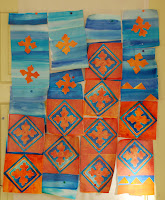I started this blog when I was just finishing two years of studying photography with the Open College of Art - and I was amazed at how much I had to learn - not just about the use of a camera, but also about the qualities of light and colour. How for example - in art we call red a hot colour and blue a cold, but in terms of physics a blue flame or blue light is hotter that red. How to use the white balance to adjust between sunlight - white, and tungsten - yellow and how the the light will vary during the day. I don't use the knowledge consciously, but some of it has rubbed off and made me more aware of these factors when taking photographs.
Colour theory is something I have been aware of, like you, I guess, since school. But when I was heavily into watercolour a good few years ago I read an article by a man called Brian Wilcox called "Blue and Yellow Don't make Green" which actually should be called blue and yellow 'don't necessarily' make green. I haven't read this, but I have got his book on colour mixing and bought a set of his basic palette of watercolours, with which he reckons you can mix all the colours you need.
He expostulates that a set of red, yellow and blue paints won't do and that you need a warm and cool version of each colour and his set of paints contain the best examples of these - of course all paints are a mix of chemicals and can never be 'pure' like the colours of the spectrum. (By the way since painting these I have learned that it is convention to have yellow at the top)
However one colour I did not have or could not mix was a magenta, until I bought a lovely bottle of bright pink magenta acrylic ink. But where did that fit on my spectrum? More later...
Meanwhile I have been working on my City and Guilds course, putting together ideas for actually making a quilt.
One of my tasks is to look at a contemporary practitioner and think about what makes her work attractive to me. I chose
Alicia Merret whose work I read about in Quilting Art magazine and then I saw her work at FOQ. What attracted me to was her use of colour (as well as her free-form cutting) and further reading revealed that she had studied the work of
Josef Albers (1888-1976) and
Johannes Itten (1888- 1967) who had both written ground breaking works on colour theory.
Alicia talks about 'simultaneous contrast" these are the complementaries that seem to vibrate.
To create these complementaries it is necessary to change the traditional colour wheel and add magenta and cyan. It is impossible to mix a proper magenta and a cyan is pretty tricky too. So where is magenta on the spectrum? Well if we bend the spectrum into a circle - like we do with a colour wheel it sort of fits where the ends meet - indigo meets red, but we know these don't mix to make magenta.
Are you still with me? You are doing better than me, I can only just get my head round all of this, but if you are interested the short slide show called
Everything You Know About Colour is Wrong on this
page has an explanation. Pointless for me to try.
Of course paint, ink and dye act very differently to the pure colours on our computer screens, but many artists develop an intuitive feel when working with colour. Back to Alicia Merret's quilts it is easy to see how her knowledge has fine tuned her instinctive selection of fabrics.
I'm not sure how all of this is going to effect my quilt design, but is is fascinating to me and will help inform me as to why my instincts tell me something is right or wrong. I am also beginning to realise how small adjustments in colour can make a huge difference and why when I put some colours together, they are just not doing what I want them to do.
Playing with complementaries
I thought this gerbera was more orange until I put it on this blue
The closest to magenta in the garden
I have ordered a copy of Josef Albers' "Interaction of Colour" which is still in print, but the Johhannes Itten's books are a little out of my price range - many copies in the hundreds of pounds, although there are second hand copies available from the USA.
Now I need to get back to some practical activities.
Thanks for sticking with me.
Jill






































